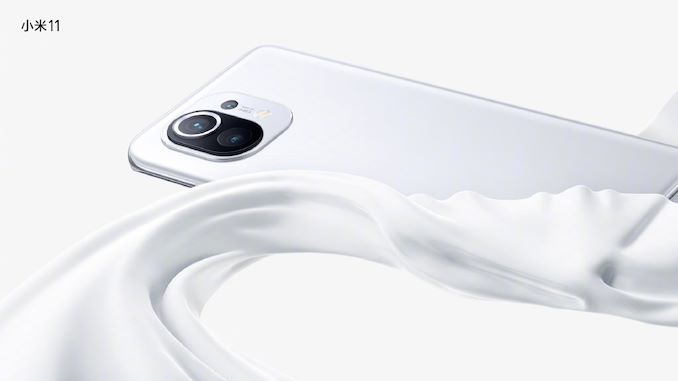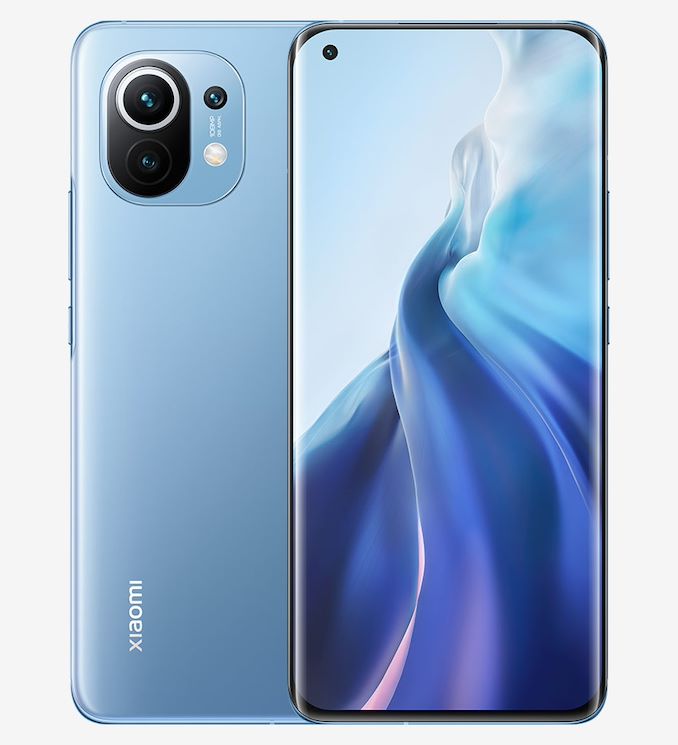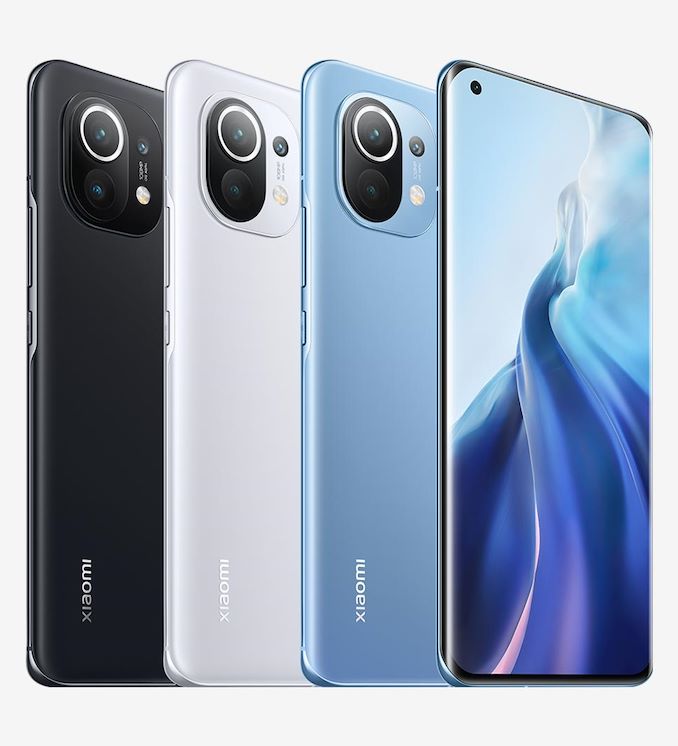Xiaomi Announces the Mi 11: First Snapdragon 888 Device
by Andrei Frumusanu on December 28, 2020 9:30 AM EST- Posted in
- Mobile
- Smartphones
- Xiaomi
- Snapdragon 888
- Mi 11

Today Xiaomi held the Chinese launch announcement of the new Mi 11 – the company’s new mainstream flagship phone for 2021. The new phone features a new super-high-end OLED screen that ticks off every checkmark feature that you’d expect from a 2021 design, including 1440p resolution and 120Hz refresh rates, features the new Snapdragon 888 SoC at its heart – as well as comes in a new thinner, lighter, and more stylish industrial design compared to its predecessors.
| Xiaomi Mi Series | |||
| Mi 10 | Mi 11 | ||
| SoC | Qualcomm Snapdragon 865 1x Cortex-A77 @ 2.84GHz 3x Cortex-A77 @ 2.42GHz 4x Cortex-A55 @ 1.80GHz Adreno 650 @ 587MHz |
Qualcomm Snapdragon 888 1x Cortex-X1 @ 2.84GHz 3x Cortex-A78 @ 2.42GHz 4x Cortex-A55 @ 1.80GHz Adreno 660 @ 747MHz |
|
| DRAM | 8GB LPDDR5-5500 | 8/12GB LPDDR5-6400 | |
| Display | 6.67" AMOLED 2340 x 1080 (19.5:9) 90Hz Refresh |
6.81" AMOLED 3200 x 1440 120Hz Refresh 480Hz Touch HDR10+ / 10-bit panel |
|
| Size | Height | 162.58mm | 164.3mm |
| Width | 74.80mm | 74.6mm | |
| Depth | 8.96mm | 8.06mm | |
| Weight | 208g | 196g | |
| Battery Capacity | 4780mAh (Typical) 30W Charging |
4600mAh (Typical) 55W Charging |
|
| Wireless Charging | 30W | 50W | |
| Rear Cameras | |||
| Main | 108MP 1/1.3" 0.8µm 4:1 Binning to 27MP / 1.6µm f/1.69 w/ OIS |
108MP Module f/1.85 w/OIS |
|
| Telephoto | - | 5MP 50mm eq. f/2.2 |
|
| Extra Telephoto |
- | - | |
| Ultra-Wide | 13MP 1.12µm f/2.4 117° FoV |
13MP f/2.4 123° FoV |
|
| Extra | 2MP Depth Camera 2MP Macro Camera |
- | |
| Front Camera | 20MP 0.8µm f/2.3 |
f/2.2 | |
| Storage | 128 / 256GB UFS 3.0 |
128 / 256GB | |
| I/O | USB-C | ||
| Wireless (local) | 802.11ax (Wifi 6), Bluetooth 5.1 |
||
| Cellular | 4G + 5G NR NSA+SA Sub-6GHz | ||
| Special Features | Under-screen fingerprint sensor Full-range stereo speakers |
||
| Splash, Water, Dust Resistance | No rating | ||
| Dual-SIM | 2x nano-SIM | ||
| Launch OS | Android 10 w/ MIUI | Android 11 w/ MIUI | |
| Launch Price | 8+128GB: 799€ 8+256GB: 899€ |
? | |
At the heart of the new Mi 11 lies the new Qualcomm Snapdragon 888 SoC. The new 5nm chip is the first to use Arm’s new Cortex-X1 cores, with Qualcomm also claiming large GPU performance boosts this generation. What’s more different from the previous Snapdragon 865 flagship design is that the new S888 reverts back to a monolithic SoC design that integrates the 5G modem back into the SoC – in turn this means that there’s more PCB component space in available inside the phone and vendors can optimise their designs better.
The new Mi 11 also features either 8GB or 12GB of the new LPDDR5 memory at its full 3200MHz speed (6400MT/s), and comes in either 128GB or 256GB storage variants, although we’re missing details on the specifications of the modules used here.
In terms of design, the new Mi 11 is quite a departure from the Mi 10, being a much sleeker device than its predecessor. Xiaomi has been able to reduce the bezels of the device on all sides, still using a curved front and back glass design that fits well into your palms. The new design is actually 0.9mm thinner than its predecessor, now coming in at 8.06mm, and also shaves 12g off its weight at 196g – still relatively heavy, but not as much as its predecessor.
The most exciting feature of the Mi 11 has to be the new OLED screen. It’s grown a bit compared to its predecessor, filling in the space in place of the bezels, going from 6.67” to 6.81”, but the most important aspect of the phone is the fact that this is now a QHD class resolution at 3200 x 1440 – a first from Xiaomi OLED screen and a resolution we haven’t seen used by the company since back in the LCD days.
Furthermore, this is a bleeding-edge display, featuring a 120Hz refresh rate, and is advertised as being a new generation 10-bit panel that also features up to 8192 brightness levels – pointing out to a new generation DDIC. The panel also is advertised as using a new next-generation emitter material, and Xiaomi claims it goes up to 1500 nits brightness, which is a notch above what we’ve seen from 2020 phones.
Lastly, like a cherry on top of the cake, the panel features a staggering 480Hz touch input rate, which is the highest we’ve heard of in the mobile industry, and hopefully results in outstanding touch input and scrolling fluidity.
Other features of the new design includes a redesigned camera setup, which transitions from a completely vertical camera arrangement to a new rounded square element with three camera modules.
Instead of having a large camera bump edge and a single glass element protecting the whole camera arrangement, Xiaomi uses a three-step glass element, each thicker than the other, protecting the three cameras modules. It looks quite interesting and gives off a much more organic feel compared to other rectangular or more symmetric camera arrangements out there.
Unfortunately for today’s announcement the Mi 11’s camera specifications were quite sparse. What we do know is that the main camera is again a 108MP module, similar to that of its predecessor, but we don’t know if it’s the exact same sensor, or a newer iteration. What we do know is that the optics are definitely different as the aperture now lands in at f/1.89 instead of f/1.69 – an actual positive change in my view as the optics of the Mi 10 was one of its main weaknesses.
Alongside the main camera there’s a 13MP ultra-wide angle with a 123° FoV and F/2.4 aperture, as well as a 5MP 2x optical 50mm equivalent telephoto module with f/2.2. That latter module sounds a bit lacklustre – maybe we’ll see an eventual Mi 11 Pro with a stronger telephoto module.
Today’s announcement covers the Chinese variant of the phone, with the global and European variants certainly to follow in the next few weeks. Pre-orders for the Chinese models start today with delivering going out the 1st of January, with the Mi 11 with an 8+128GB variant coming in at ¥3999.00, or USD $611. Western prices are certainly set to be different, but that’s already a quite promising start for the new flagship.
Related Reading:
- Xiaomi Globally Launches Mi 10, Mi 10 Pro; Snapdragon 865 & 108MP Cameras
- The Xiaomi Mi 10 Pro Review - A Solid Overall Value
- Xiaomi Announces Mi 10T & Mi 10T Pro: More Budget, But With 144Hz
- Xiaomi Launches Mi Note 10 Lite, Redmi Note 9 & Note 9 Pro Globally













82 Comments
View All Comments
Duncan Macdonald - Monday, December 28, 2020 - link
The high power (55W) charging may be good for short charging times - however it will not be good for the life expectancy of the battery. (Even a cheap 1A (5W) USB charger can fully recharge a phone overnight - and it would be nothing like as damaging to the battery.)If the phone is used at full brightness (eg watching a video) how long will the battery last - and how hot will the phone become? Also how long will it be before panel degradation becomes visible if the phone is used at full brightness?
shabby - Tuesday, December 29, 2020 - link
Here comes the battery engineer... do you know the chemistry of this exact battery? Do you know its maximum charge current? Maybe it's made up of 2 cells so you're really charging each cell at only 22.5w.nemi2 - Thursday, December 31, 2020 - link
Didn't matter if it is 20 cells. If it's packed into the same volume the total surface area of the electrodes will be about the same (actually less as you increase the battery count in the same volume as there is outer packaging hitting the available electrode volume). The higher the current (and heat) the more the reduction in battery lifetime charge cycles.shabby - Thursday, December 31, 2020 - link
Again until you know the specification of the actual cell what you're saying is too generic. Lipo cell's can charge at very high currents as can some 18650. Go look up some data sheets for these batteries and you'll see every single one varies, the more $$$ the better the charge/discharge current it can take.Silver5urfer - Thursday, December 31, 2020 - link
This BS double cell or single cell is nothing when you see the basic chemistry, the faster the charge rate which is C, and the higher the voltage and current. The battery depletes faster. Period.Any battery will lose it's total capacity while shoving fast chargers over and over rather than a 30-80% cycle. And on top this is an irreversible process.
I see my phone discharge fast when used with a fast charger QC2.0, vs the fast charge to 60% from 25% and then charge with USB 3.0 from 60-80%. I literally saw this with my personal use case.
Fast charging is only useful for very low % of the charge left to the medium. You don't require battery engineering bs, just a simple google will explain how things work.
s.yu - Saturday, January 2, 2021 - link
That's generally how fast chargers work, they charge fast until 50-60% and then taper down, the last 10% is usually pretty slow.One could argue if it could taper earlier and charge the last 40% at around 5W though.
NXTwoThou - Tuesday, December 29, 2020 - link
The Mi10 Ultra, when charging at 80W was 43.8C. 21 minutes from 0 to 100%. If you haven't kept up on battery tech, an awful lot has changed in a short period of time. That's not to say they used 10 Ultra tech in the Mi 11, but you'd at least think they learned a thing or two. We'll have to wait for reviews.philehidiot - Tuesday, December 29, 2020 - link
There is no doubt that using fast charging will be detrimental to the battery. The extent of the decline in longevity is the question and reviews will not tell you a thing about it. We will never know the full extent of the impact as no one is going to buy people a load of phones and do a study. The manufacturer will likely know as the battery / charging system will be validated. If theirs was anything special, you can guarantee that they would be bragging about it.Myself, I have a standard, slow USB wireless charger which runs at around 1A and use that overnight for routine charging. Next to it lies the cable for the fast charger. I use that for top ups in a hurry.
Given there is no doubt that these rapid chargers will increase the rate of degradation compared to a "slow" charger (the question is by how much), I much prefer the approach of Asus who alert you to the effects in the charge settings.
NXTwoThou - Wednesday, December 30, 2020 - link
https://sparrowsnews.com/2020/08/12/is-xiaomi-mi-1... Here's a read up on what Xiaomi did with their previous phone. They claim 800 cycles and still 90% effective capacity(compared to 60% after 400 cycles on conventional). That's with the 120W charging.dudedud - Saturday, January 2, 2021 - link
Didn't OPPO claim the same thing but when Andrei asked for the methodology (to reproduce it and prove it) they didn't respond?I think there's a tweet of him about it.